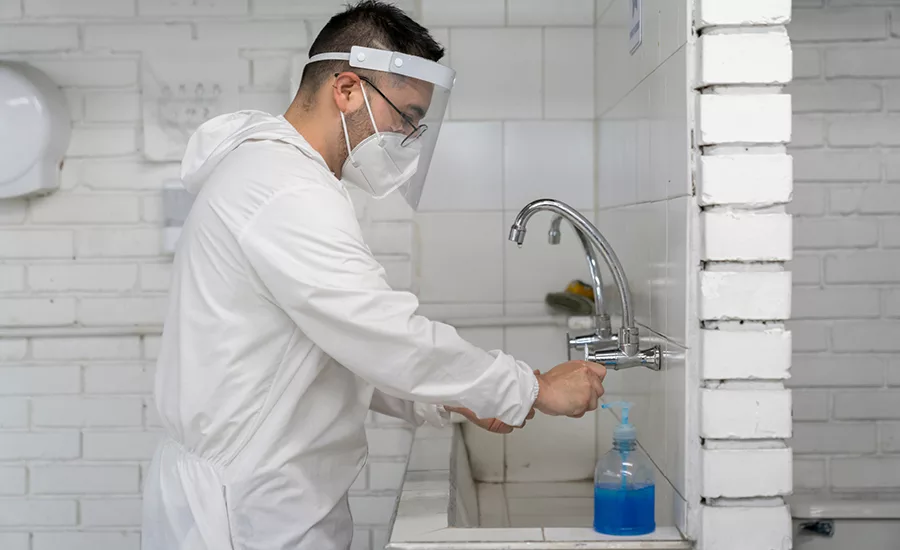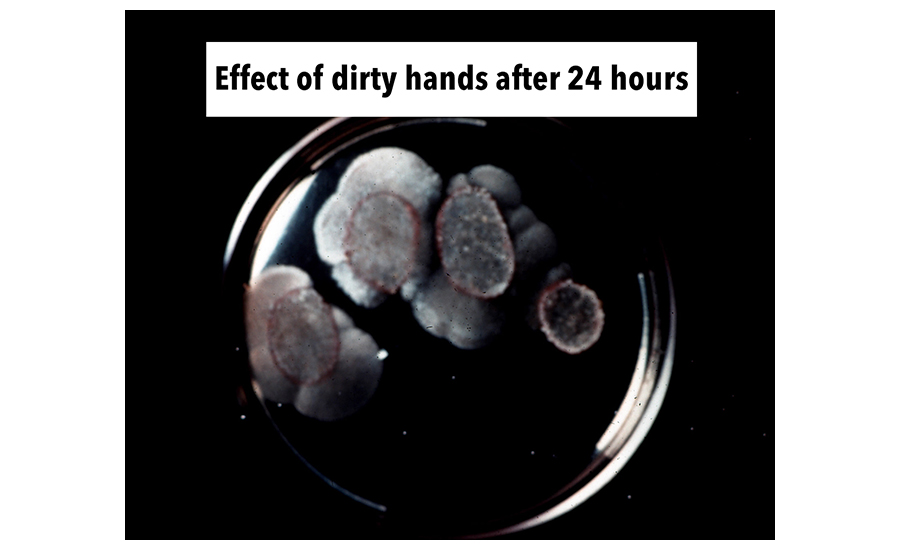Food Safety
Getting handwashing right
Often overlooked, but vital for safe food handling and processing, here are some strategies for implementing a handwashing program in your operation

The number of handwashing stations at facility entrances should be sufficient to ensure workers will wash their hands and not bypass the stations. Photo courtesy of Getty Images/andresr
When the COVID-19 pandemic started, handwashing and sanitizing was one of the preventive measures adopted throughout the world as a means of slowing the spread of the virus. Scientists had not yet determined that COVID-19 was a respiratory virus and not spread through hands or food. Since handwashing is a key element of the food quality and safety programs for food processors, meeting this early mandate was not a major issue for the industry. But how should companies go about ensuring that their people not only wash their hands, but that handwashing is effective?
There are four basic elements processors should include in their handwashing:
- Developing and documenting the procedure
- Education
- Establishing and properly locating handwashing stations
- Monitoring and maintaining the program
Now, these four elements are not “stand-alone” points but they must be viewed as part of a systematic approach to proper handwashing. As an example, one cannot draft procedures without knowing equipment and well-documented protocols are an essential element for training and education.
The first step for a handwashing program is developing and documenting how workers shall wash their hands and how the program will be managed. These procedures must be based on the handwashing equipment the company has adopted. A standard procedure might consist of the following:
- Wetting hands with warm water
- Washing with soap for at least 20 seconds
- Rinsing the soap with warm water
- Drying hands using clean towels or an electronic hot air dryer
- Apply a sanitizer (optional)



The protocols that are drafted must describe how the workforce should use the handwashing equipment. To minimize potential contamination of hands and enhance handwashing efficiency, it is recommended that handwashing stations be hands-free. If workers have to manipulate spigots or taps, these must be touched before and after washing, and what was on the dirty hands may be transferred to the tap and back to the hands. Procedures must be clearly written so they may be easily understood by workers and trainers.
Education and training
Workers must be educated using the documented protocols. The trainers must never deviate from what was written. Handwashing should be an integral element of a company’s orientation for new employees and the yearly refresher sessions. These sessions, especially for new hires, should include a practical element, that is, each and every participant should actually have the opportunity to wash their hands using all the different handwashing options in the facility.
These sessions must also emphasize the importance of handwashing for ensuring the production of safe food. Since many plant workers have little understanding of basic microbiology and foodborne illness, the sessions should also be designed to provide some background on these subjects. One excellent tool used by many companies are the petri dishes/plates with media to demonstrate that hands do contain bacteria and how handwashing and sanitizing can remove those organisms. Ask workers to touch petri dishes with the tips of their fingers. Ask the same people to wash and/or sanitize hands and touch a plate. Bring the group together later to view the media so they can see the results.
Another excellent tool for processors are the products manufactured by GLO-GERM. One product is a fluorescent powder that can be placed on hands. The powder will be transferred to any surface or person he or she touches. Using an ultraviolet light, the places touched by the person will fluoresce demonstrating how bacteria may be spread.
The company also manufactures a cream that fluoresces. Ask one or more of the participants to rub the product into their hands as they would a hand cream and then have them wash their hands. Once they have finished washing up, turn out the lights and shine the ultraviolet light on their hands. Any residual cream will glow indicating that the person did not wash properly.
These sessions must also emphasize when workers wash their hands, that is, at the start of the work day, after breaks and meals and whenever they may have soiled their hands such as moving a trash bin. The bottom line is that workers may end up washing their hands between 5 – 10 times per day.
One excellent tool used by many companies are the petri dishes/plates with media to demonstrate that hands do contain bacteria and how handwashing and sanitizing can remove those organisms.
Handwashing stations
Food processors must establish handwashing stations throughout their facilities. The location of these stations and the type of system in place should be addressed during the training sessions. Handwash stations should be established at all employee entrances to the facility. The number of stations established at the entrances should be sufficient to ensure that workers will wash their hands and not by-pass the wash stations.
The USDA-FSIS has established guidance for the number of handwash stations or toilets based on the number of employees. The rule of thumb is one station for every ten employees. Many operations will also stagger start times and breaks for their staff to ensure that lines do not develop at handwash stations. Handwash stations should also be set up throughout the production floor. Workers often need to wash up during the work day. If handwash stations are not conveniently located, people may simply ignore the fact that their hands are dirty. No one wants to walk several hundred yards to find a handwash station.
As noted earlier, handwash stations must be hands-free to minimize the potential for cross-contamination. These systems may be foot or knee operated, or can be engaged using electric eyes. The latter can be a problem as they are generally battery operated. It seems that the batteries tend to die during audits which results in a downgrade, so an integral part of the maintenance program for these systems is changing batteries on a regular schedule.
Each handwash station must be properly supplied—including, at a minimum, having warm water, soap and a means to dry hands after washing. Warm water is essential as it performs several functions. These include makes fats easier to remove, enhancing the action of soap and, perhaps most important, making handwashing more comfortable for the plant workers. It is certainly not comfortable to wash in very cold water. Delivery systems for soap and towels should also be hands-free. Some processors have installed hot-air hand dryers at their handwash stations. These are hands-free and very effective, although there are some food safety professionals who feel the air dryers can spread aerosols throughout the plant. These systems also have filters that should be monitored and changed on a regular schedule. Lastly, if the handwash station includes a sanitizing step, that too should be hand-free.
There are a number of automatic handwash systems available to the food industry. With these systems, workers insert their hands into tubes or barrels on a panel. This activates a sensor that initiates the handwashing process. One supplier of these systems is Meritech. Their systems will clean hands in 12 seconds using water and cleaning solutions, utilize less water than traditional handwashing systems and are comfortable for the workforce. The company also claims 99.9% removal of pathogens. The handwash cycle consists of two seconds of water pre-rinse; four seconds of hygiene solution/water mix; and six seconds potable water rinse. The systems may even include a built-in boot washer.
Monitoring and Management
Since handwashing is such an important element for food safety, especially when producing ready-to-eat products, it is imperative that processors make sure the handwashing program is operating as designed. One part of this is monitoring the handwashing stations to ensure that they are properly supplied with soap, towels and sanitizers if the company deems that to be necessary. This entails establishing schedules to check the handwash stations regularly, record the results of these checks and replace any items that are running low. The inspection schedule should be designed to “catch” items before they run out.
To ensure the workforce actually follows the handwashing policy, some companies install cameras to monitor handwashing. Others will routinely observe the handwashing stations to verify that workers are washing up properly. Another tool for verification is to establish a program whereby workers will have their hands swabbed as they enter the processing area after washing up. This program is not meant to target individuals but to create an awareness that handwashing is important and management supports the program. Workers whose hands are found to be dirty are not disciplined, but reminded to take greater care when washing up. Results are reported to the whole workforce allowing them to better understand how the team is complying with the policies. Companies should also conduct yearly refresher sessions for employees on the importance of handwashing and what is expected of each worker.
Finally, management should incorporate handwashing stations into their preventive maintenance program. Monitor and maintain the equipment as recommended by suppliers and maintain maintenance records. This may be done internally or processors can establish maintenance contracts with the equipment manufacturers.
Looking for a reprint of this article?
From high-res PDFs to custom plaques, order your copy today!






